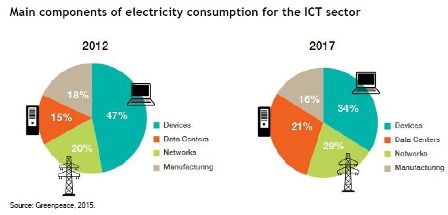
Empowering Energy Efficiency in Service Provider Networks
One of the best gifts my husband and I received is a robotic vacuum cleaner that we decided to name Ambrogio. We only need to remember to press Ambrogio’s clean button before leaving in the morning. When we come home in the evening, we find our apartment clean. Not only does Ambrogio do a great job, but he is also very parsimonious. In fact, his power consumption is minimal compared to a traditional vacuum cleaner, which is great for our household budget.
No one understands the impact of steep energy costs on budgets like mobile service providers, for whom energy is a top expense. It’s estimated that providers account for $15 billion in annual energy expenditures, or about one percent of all energy consumed worldwide. Caught between rising energy prices and customer demand, that’s only going to increase—both as a factor of cost and as a percentage of use.
Energy efficiency has, unsurprisingly, become a top priority for service providers. It can reduce stress on the budget, improve customer retention and reduce a network’s carbon footprint. This last factor can have deep significance in terms of public relations, regulatory expectations, and a matter of good global corporate citizenship.
So as the Internet of Things (IoT) expands and universal connectivity grows at an explosive pace—the IoT market is expected to reach a staggering $1.7 trillion in just four short years—how are service providers going to pay the electric bill, keep growing their networks and shrink their carbon footprint?
According to a new report just published by IDC in conjunction with CommScope, energy efficiency will be best exercised not as a single, monolithic effort but as a carefully considered strategy using multiple new solutions and advanced innovations. While I urge you read the report in its entirety, here are a few of the items it covers:
- Radio Access Network (RAN) Modernization. RAN energy costs can amount to as much as 15 percent of a service provider’s total operating expenditures, with radio sites being the biggest energy use factor, and rural, isolated locations being the biggest challenge to efficiency. Remote radio architecture can reduce RAN power consumption dramatically—at least 50 percent, according to one network—and operators can achieve better efficiency overall through the use of pre-assembled, factory-configured tower tops.
- Data Center Management. The growth of cloud-based services and virtualized hardware has put a lot of stress on data center infrastructure for service providers. Between now and 2018, it’s estimated that service providers will account for nearly half of all new data center construction. Data center infrastructure management holds the key to more efficient operations, from more fully provisioning assets to automating environmental controls.
- Intelligent Buildings. The industry has evolved from the simple temperature sensors and rules-based programming of early intelligent buildings. The renewed emphasis on energy efficiency means new platforms have greatly increased their functionality and potential. Now, ubiquitous sensor networks paint a complete picture of energy use across the entire building, in multiple dimensions, opening new avenues of efficiency.
